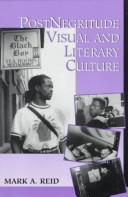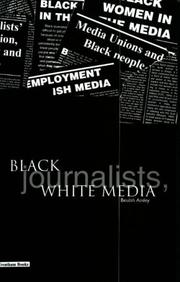| Listing 1 - 6 of 6 |
Sort by
|

ISBN: 0585076626 9780585076621 0791433013 0791433021 9780791433010 9780791433027 1438417055 9781438417059 Year: 1997 Publisher: Albany State University of New York Press
Abstract | Keywords | Export | Availability | Bookmark
 Loading...
Loading...Choose an application
- Reference Manager
- EndNote
- RefWorks (Direct export to RefWorks)
In the 1960s and 1970s, the civil rights movement and other national and cultural movements fractured dominant paradigms of American identity and demanded a reformulation of American values and norms. This book borrows the moral, ethical, and political purposes of these movements to show how film, literature, photography, and television news broadcasts construct essentialist myths about race, gender, sexuality, and nation. It also examines how some visual and literary works and public reactions challenge these essentialist myths by exploring racial, sexual, and national anxieties.
Blacks and mass media. --- Mass media and Blacks --- Mass media --- Blacks and mass media --- Mass media and Black people --- Black people and mass media.

ISBN: 1858560586 Year: 1998 Publisher: Stoke-on-Trent : Trentham books,
Abstract | Keywords | Export | Availability | Bookmark
 Loading...
Loading...Choose an application
- Reference Manager
- EndNote
- RefWorks (Direct export to RefWorks)
Blacks and mass media --- Minority journalists --- Race relations and the press
Book
ISBN: 0773412204 9780773412200 9780773429208 0773429204 Year: 2012 Publisher: Lewiston Edwin Mellen Press
Abstract | Keywords | Export | Availability | Bookmark
 Loading...
Loading...Choose an application
- Reference Manager
- EndNote
- RefWorks (Direct export to RefWorks)
Sociologists can learn a lot from studying a group's media consumption patterns. In this study, Ogunyemi researches what stories are most resonant with Black Africans living in England. The book tries to discover whether or not this minority group adopts normative approaches to media coverage, by not only consuming but participating in media. It also discusses the omission of African stories by the mainstream media in England. This book will contribute to understanding ethnic media trends.
African diaspora. --- Blacks and mass media -- Great Britain. --- Mass media -- Great Britain -- Audiences. --- Mass media and immigrants -- Great Britain. --- Minorities and journalism -- Great Britain. --- Blacks and mass media --- Minorities and journalism --- Mass media and immigrants --- Mass media --- African diaspora --- Journalism & Communications --- Journalism --- Black diaspora --- Diaspora, African --- Human geography --- Africans --- Immigrants and mass media --- Immigrants --- Journalism and minorities --- Minorities and the press --- Mass media and Blacks --- Audiences --- Migrations --- Mass media and Black people --- Black people and mass media -- Great Britain. --- Black people and mass media --- Transatlantic slave trade --- Great Britain --- Africa --- Emigration and immigration --- Eastern Hemisphere
Book
ISBN: 0295999586 9780295999586 9780295999562 029599956X 9780295999579 0295999578 Year: 2017 Publisher: Seattle
Abstract | Keywords | Export | Availability | Bookmark
 Loading...
Loading...Choose an application
- Reference Manager
- EndNote
- RefWorks (Direct export to RefWorks)
Migrating the Black Body" explores how visual media - from painting to photography, from global independent cinema to Hollywood movies, from posters and broadsides to digital media, from public art to graphic novels -has shaped diasporic imaginings of the individual and collective self. How is the travel of black bodies reflected in reciprocal black images? How is blackness forged and remade through diasporic visual encounters and reimagined through revisitations with the past? And how do visual technologies structure the way we see African subjects and subjectivity? This volume brings together an international group of scholars and artists who explore these questions in visual culture for the historical and contemporary African diaspora. Examining subjects as wide-ranging as the appearance of blackamoors in Russian and Swedish imperialist paintings, the appropriation of African and African American liberation images for Chinese Communist Party propaganda, and the role of YouTube videos in establishing connections between Ghana and its international diaspora, these essays investigate routes of migration, both voluntary and forced, stretching across space, place, and time.
African diaspora in art. --- Art. --- Blacks in mass media. --- Mass media --- Art, Occidental --- Art, Visual --- Art, Western (Western countries) --- Arts, Fine --- Arts, Visual --- Fine arts --- Iconography --- Occidental art --- Visual arts --- Western art (Western countries) --- Arts --- Aesthetics --- Blacks and mass media. --- Blacks in mass media --- Black people in mass media. --- Black people and mass media. --- Art, Primitive
Book
ISBN: 1868148505 1868145921 1868145719 Year: 2012 Publisher: Johannesburg : Wits University Press,
Abstract | Keywords | Export | Availability | Bookmark
 Loading...
Loading...Choose an application
- Reference Manager
- EndNote
- RefWorks (Direct export to RefWorks)
This much-awaited volume uncovers the long-lost pages of the major African multilingual newspaper, Abantu-Batho. Founded in 1912 by African National Congress (ANC) convenor Pixley Seme, with assistance from the Swazi Queen, it was published up until 1931, attracting the cream of African politicians, journalists and poets Mqhayi, Nontsisi Mgqweth, and Grendon. In its pages burning issues of the day were articulated alongside cultural by-ways. The People's Paper - comprising both essays and an anthology - explores the complex movements and individuals that emerged in the almost twenty years of its publication. The essays contribute rich, new material to provide clearer insights into South African politics and intellectual life. The anthology unveils a judicious selection of never-before published columns from the paper spanning every year of its life and drawn from repositories on three continents. Abantu-Batho had a regional and international focus, and by examining all these dynamics across boundaries and disciplines, The People's Paper transcends established historiographical frontiers to fill a lacuna that scholars have long lamented.
Journalism --- Blacks and mass media --- Black newspapers --- South African newspapers --- Writing (Authorship) --- Literature --- Publicity --- Fake news --- Mass media and Blacks --- Mass media --- Newspapers, Black --- Newspapers --- History. --- South Africa --- Politics and government --- Mass media and Black people --- Black people and mass media
Book
ISBN: 9782363158697 Year: 2017 Publisher: [chez l'auteur], Kwandika,
Abstract | Keywords | Export | Availability | Bookmark
 Loading...
Loading...Choose an application
- Reference Manager
- EndNote
- RefWorks (Direct export to RefWorks)
Mass media and minorities. --- Mass media and ethnic relations. --- Médias et minorités. --- Médias et relations interethniques. --- Noirs et médias --- Blacks and mass media. --- Dans les médias. --- Black people and mass media. --- AFRIKA -- 07 --- ZWARTE MENSEN -- 07 --- Médias et minorités. --- Médias et relations interethniques. --- Noirs et médias --- Dans les médias. --- Relations interethniques
| Listing 1 - 6 of 6 |
Sort by
|

 Search
Search Feedback
Feedback About UniCat
About UniCat  Help
Help News
News